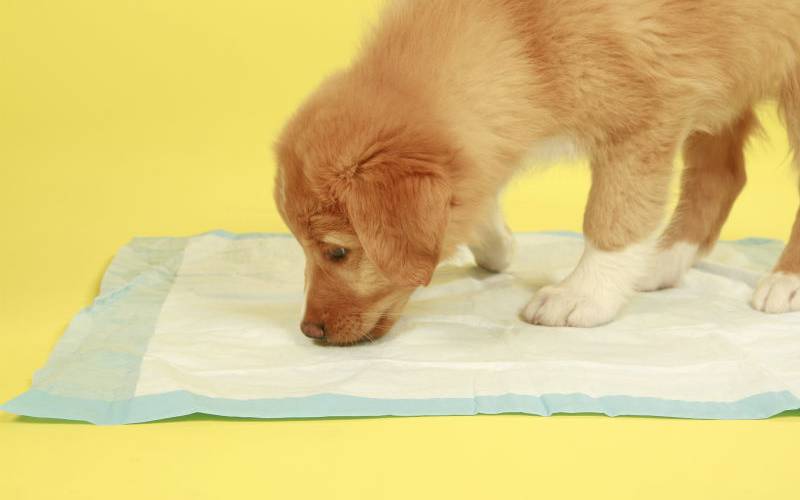patterdaleterriers.co.uk is a participant in the Amazon Services LLC Associates Program and other affiliate advertising programs designed to provide a means for us to earn fees by linking to Amazon.co.uk and affiliated sites. Affiliate links may be used on this page and in patterdaleterriers.co.uk articles, but they do not impact on the price that you pay and they do help me to get this information to you for free. Read my privacy policy for more information regarding affiliates.
Bringing your new puppy home is a delight for all the family…..that is until you realise how frequently they need to pee or poop! House training a puppy is a challenge, but you will be glad to know that with the right training they will pick it up extremely quickly. There is plenty of information available along with things that can make it easier such as training sprays and puppy pads.
Dogs naturally like to ‘go to the loo’ in the same place or a place that they know is their toilet, such as peeing up a bush or on a patch of grass in the yard. This comes quite naturally to them and they don’t like to soil their own beds. So combining this habit with a bit of positive reinforcement will do the trick.
When and how to start House Training a Puppy
Of course it depends on how old your pup is when you get it, but as a general rule it’s a good idea to start as soon as you get your new puppy home. Decide how and where you will be training, such as using a crate or newspaper. Make sure that you have a place for him or her to ‘go’ which will usually be outside. Our Blake has his peeing patch of grass in the back yard. Then arm yourself with some healthy puppy treats to reward the dog within 5 seconds (if possible) of going to the toilet in the right place.
The Advantages of Using a Crate
A crate has the added advantage of keeping your pup safe and secure. It’s supposed to be a comfortable place for your pup, not a place of punishment so don’t use it in that way. Make sure that the crate is the appropriate size for the breed and that he has plenty of room to stand up and turn around in. Generally, a dog will not poop or pee in his own crate because then he will have to sit in it! You can feed your dog in his crate and also make it a nice cosy place for him or her with blankets and toys. When he is comfortable in his crate then you can regularly take him outside to do his business. If he doesn’t go that’s ok, ignore, but if he does, treat immediately and make a massive fuss!
Keep Your Eyes Peeled!
It’s really important to keep a close eye on your pup in the early days of housetraining. Anytime that he looks like he’s about to ‘go’ like sniffing or making circles, put him straight outside on his toilet patch! Praise when he does of course! You can then start to add in a command what you say to him regularly. With Blake we say ‘go to the loo!’ and he picked it up quickly (within 3 days).
Have a Schedule
Having a regular schedule for walking will help your dog to go outside. They will get used to peeing and pooing on their walks pretty quickly. They like routine for their habits and bodily functions. So for example, one morning walk and one evening walk plus going outside every hour or two should sort it out. With Blake, the only few times he slipped up in the early days and went in the kitchen are when we missed his schedule for his morning walk.
Don’t Let the Puppy Roam
Letting your puppy roam around the house alone before he or she is housetrained is likely to result in accidents, especially as they like to ‘mark’ their territory! Ideally you don’t want to confine your puppy to his crate as he should be socialising, so try to arrange to have someone available to be watching over him for at least the first few days of training.
Using Puppy Spray or Puppy Pads
Some people like to use training aids such as puppy training spray or puppy pads to help your puppy to go. We found that we didn’t need them, but then again we didn’t have Blake from a puppy. Many puppy owners like puppy pads because they are ultra absorbant and so some dog owners use them for in the kitchen at night. Then they move the puppy pads towards the door before completely taking them away when the puppy is house trained.
- Includes 100 regular size, standard absorbency pee pads for dogs
- 5-layer construction; super absorbent core turns liquid into gel on contact
- Quick-dry surface with built-in attractant for potty training; leakproof plastic lining keeps floors safe from damage
Don’t Get Discouraged
There will be times when you find it quite frustrating house training a puppy, but don’t give up or be discouraged. Just be persistent with schedule and where he goes to the loo and he or she will soon pick it up. Eventually your pup will figure out a way to ask you to go to the loo by scratching at the door or barking and then running to it.
Another helpful article on toilet training is: Why is my dog peeing on my bed? by Tiffany at Pennies, places and paws.
You might also like to read about Dog Crate Covers



